Old and Modern Wooden Buildings in the Context of Sustainable Development
Abstract
1. Introduction
2. Materials and Methods
2.1. Most Common Damage to Structural Timber Members
2.2. Structural Timber Testing—Condition Assessment
- Tomograph,
- Resistographs,
- Pilodin (a device designed to evaluate the cutting resistance of wood),
- A thermal imaging camera.
2.3. The Use of Neural Networks for the Prediction of Selected Wood Characteristics
- Approximation forecasts the prediction of outputs without having to explicitly define the relationship between these data;
- Classification and pattern recognition;
- Data association;
- Analysis and processing of predictive data.
- n input signals xi with weight wi;
- One output signal y;
- The excitation e of the neuron, which is the sum of the weighted input signals, is expressed as:
- activation (transition) function f(e).
- Unidirectional networks;
- Recurrent networks;
- Self-organising maps.
- Layered linear networks (Adaline/Madaline, Multilayer Perceptron).
- Layered nonlinear networks.
- ◦
- Networks learned by back-propagation (BP) algorithm.
- ◦
- Networks with circular symmetry function (RBF).
- Feedback networks.
- ◦
- Hopfield networks.
- ◦
- Networks with bidirectional associative memory (BAM).
- Competition learning networks.
- ◦
- Kohonen Network (LVQ).
- ◦
- Self-organising network (SOM).
- Resonance networks (ART).
- Hybrid networks.
- Obtained through the implementation of the FuzzyARTMAP network;
- Based on the BP back-propagation network concept;
- Based on networks that use connections between neurons and other nearest neighbour neurons, the nearest neighbour method.
- Availability of the Statistica software;
- Global approximation of such networks;
- More complex topology than RBF networks;
- A backpropagation learning algorithm (more complex than nearest-neighbour networks).
3. Results
3.1. Results of “In Situ” Analyses
3.1.1. Storage of Dry Roughage
- The dead weight of the structure was defined in the program by imposing on the individual members appropriate cross-sections and by defining the wood class as C24 in the first iteration and C20 in the second iteration, while reducing the cross-sectional dimensions to the real ones resulting from the in situ tests;
- Snow was assumed as the first snow zone according to [126], so sk = 0.7 kN/m2, making it the standard load scheme as for a pitched roof;
- Wind was assumed as for the first wind zone according to [127], so vb = 22 m/s was automatically generated in the wind tunnel. The load on the wind direction θ = 0° was omitted due to the connection with the neighboring building.
3.1.2. Military Casino
3.1.3. Granary
3.2. Prediction of Selected Characteristics of Biologically Corroded Wood
- Number of inputs: 5.
- Network type: multilayer perceptron (unidirectional multilayer networks, MLP networks).
- Learning algorithm—BFGS (variable metric method).
- Number of neurons in the hidden layer: 4–6.
- Error function: sum of squares.
- Output function linear.
4. Discussion
5. Conclusions
Author Contributions
Funding
Institutional Review Board Statement
Informed Consent Statement
Conflicts of Interest
References
- Schmidt, J.; Kaliske, M. Models for numerical failure analysis of wooden structures. Eng. Struct. 2009, 31, 571–579. [Google Scholar] [CrossRef]
- Konopka, D.; Gebhardt, C.; Kaliske, M. Numerical modelling of wooden structures. J. Cult. Herit. 2017, 27, S93–S102. [Google Scholar] [CrossRef]
- Oudjene, M.; Khelifa, M. Finite element modelling of wooden structures with large deformations and brittle failure prediction. Mater. Des. 2009, 30, 4081–4087. [Google Scholar] [CrossRef]
- Marsili, R.; Rossi, G.; Speranzini, E. Fibre Bragg Gratings for the Monitoring of Wooden Structures. Materials 2017, 11, 7. [Google Scholar] [CrossRef] [PubMed]
- Harkouss, F.; Fardoun, F.; Biwole, P.H. Optimization approaches and climates investigations in NZEB—A review. Build. Simul. 2018, 11, 923–952. [Google Scholar] [CrossRef]
- Tabrizi, A.; Sanguinetti, P. Life-cycle cost assessment and energy performance evaluation of NZEB enhancement for LEED-rated educational facilities. Adv. Build. Energy Res. 2015, 9, 267–279. [Google Scholar] [CrossRef]
- Zheng, L.; Lai, J. Environmental and economic evaluations of building energy retrofits: Case study of a commercial building. Build. Environ. 2018, 145, 14–23. [Google Scholar] [CrossRef]
- Yan, Y.; Zhang, H.; Meng, J.; Long, Y.; Zhou, X.; Li, Z.; Wang, Y.; Liang, Y. Carbon footprint in building distributed energy system: An optimization-based feasibility analysis for potential emission reduction. J. Clean. Prod. 2019, 239, 117990. [Google Scholar] [CrossRef]
- Fenner, A.E.; Kibert, C.J.; Li, J.; Razkenari, M.A.; Hakim, H.; Lu, X.; Kouhirostami, M.; Sam, M. Embodied, operation, and commuting emissions: A case study comparing the carbon hotspots of an educational building. J. Clean. Prod. 2020, 268, 122081. [Google Scholar] [CrossRef]
- Yongtao, L.; Chao, H.; Xiuqin, M.; Fankun, W. Co-benefit Research on Energy Efficiency Reforming Project of District Heating System. Energy Procedia 2011, 5, 598–603. [Google Scholar] [CrossRef][Green Version]
- Proszak-Miąsik, D.; Rabczak, S. Methods for reducing low emissions from heating devices in single- family housing. E3S Web Conf. 2018, 45, 00069. [Google Scholar] [CrossRef]
- Kaczmarczyk, M.; Sowiżdżał, A.; Tomaszewska, B. Energetic and Environmental Aspects of Individual Heat Generation for Sustainable Development at a Local Scale—A Case Study from Poland. Energies 2020, 13, 454. [Google Scholar] [CrossRef]
- Raczyński, M.; Rutkowski, R. How Pro-Environmental Legal Regulations Affect the Design Process and Management of Multi-Family Residential Buildings in Poland. Energies 2020, 13, 5449. [Google Scholar] [CrossRef]
- Borys, G. Selected directions of increasing efficiency in supporting thermomodernization in buildings from public funding. Pr. Nauk. Uniw. Ekon. We Wrocławiu 2015. [Google Scholar] [CrossRef]
- Rey-Hernández, J.; Velasco-Gómez, E.; Tejero-González, A.; Rey-Martínez, F. Energy Analysis at a Near Zero Energy Building. A Case-Study in Spain. Energies 2018, 11, 857. [Google Scholar] [CrossRef]
- Marrone, P.; Gori, P.; Asdrubali, F.; Evangelisti, L.; Calcagnini, L.; Grazieschi, G. Energy Benchmarking in Educational Buildings through Cluster Analysis of Energy Retrofitting. Energies 2018, 11, 649. [Google Scholar] [CrossRef]
- Guizzardi, M.; Carmeliet, J.; Derome, D. Risk analysis of biodeterioration of wooden beams embedded in internally insulated masonry walls. Constr. Build. Mater. 2015, 99, 159–168. [Google Scholar] [CrossRef]
- Dylewski, R. Optimal Thermal Insulation Thicknesses of External Walls Based on Economic and Ecological Heating Cost. Energies 2019, 12, 3415. [Google Scholar] [CrossRef]
- Dylewski, R.; Adamczyk, J. Impact of the Degree Days of the Heating Period on Economically and Ecologically Optimal Thermal Insulation Thickness. Energies 2020, 14, 97. [Google Scholar] [CrossRef]
- Oregi, X.; Hernández, R.J.; Hernandez, P. Environmental and Economic Prioritization of Building Energy Refurbishment Strategies with Life-Cycle Approach. Sustainability 2020, 12, 3914. [Google Scholar] [CrossRef]
- Dobrzycki, A.; Kurz, D.; Mikulski, S.; Wodnicki, G. Analysis of the Impact of Building Integrated Photovoltaics (BIPV) on Reducing the Demand for Electricity and Heat in Buildings Located in Poland. Energies 2020, 13, 2549. [Google Scholar] [CrossRef]
- Ramczyk, M. Legal bases and economic conditions of applying renewable energy resources in construction industry. MATEC Web Conf. 2018, 174, 04004. [Google Scholar] [CrossRef][Green Version]
- Kozik, R.; Karasińska-Jaśkowiec, I. Green public procurement—legal base and instruments supporting sustainable development in the construction industry in Poland. E3S Web Conf. 2016, 10, 00044. [Google Scholar] [CrossRef]
- Dyrektywa 5 Parlamentu Europejskiego i Rady 2005/32/WE z Dnia 6 Lipca 2005. Available online: https://eur-lex.europa.eu/legal-content/PL/TXT/PDF/?uri=CELEX:32005L0032&from=en (accessed on 30 July 2021).
- Rozporządzenie Parlamentu Europejskiego i Rady (UE) nr 305/2011 z Dnia 9 Marca 2011 r. Ustanawiające Zharmonizowane Warunki Wprowadzania do Obrotu Wyrobów Budowlanych i Uchylające Dyrektywę Rady 89/106/EWG. Available online: https://eur-lex.europa.eu/legal-content/PL/TXT/PDF/?uri=CELEX:02011R0305-20140616&qid=1576663491684&from=EN (accessed on 30 July 2021).
- Dyrektywa Parlamentu Europejskiego i Rady 2009/125/WE z Dnia 21 Października 2009 r. Ustanawiająca Ogólne Zasady Ustalania Wymogów Dotyczących Ekoprojektu Dla Produktów Związanych z Energią. Available online: https://eur-lex.europa.eu/legal-content/PL/TXT/PDF/?uri=CELEX:32009L0125&from=ES (accessed on 30 July 2021).
- Dyrektywa Parlamentu Europejskiego i Rady 2010/30/UE z Dnia 19 Maja 2010 r. w Sprawie Wskazania Poprzez Etykietowanie Oraz Standardowe Informacje o Produkcie. Zużycia Energii Oraz Innych Zasobów Przez Produkty Związane z Energią. Available online: https://eur-lex.europa.eu/legal-content/PL/TXT/HTML/?uri=OJ:L:2010:153:FULL&from=NL (accessed on 30 July 2021).
- Commission of the European Communities. Green Paper—A European Strategy for Sustainable, Competitive and Secure Energy; Official Journal of the European Union: Brussels, Belgium, 2006. [Google Scholar]
- Życzyńska, A.; Cholewa, T. The Profitability Analysis Of Enhancement Of Parameters Of The Thermal Insulation Of Building Partitions. Arch. Civ. Eng. 2014, 60, 335–347. [Google Scholar] [CrossRef]
- Życzyńska, A.; Cholewa, T. The modifications to the requirements on energy savings and thermal insulation of buildings in Poland in the years 1974–2021. Bud. i Archit. 2015, 14, 145–154. [Google Scholar] [CrossRef]
- Basinska, M.; Koczyk, H.; Kosmowski, A. Assessment of Thermo Modernization Using the Global Cost Method. Energy Procedia 2015, 78, 2040–2045. [Google Scholar] [CrossRef]
- Basińska, M.; Kaczorek, D.; Koczyk, H. Building Thermo-Modernisation Solution Based on the Multi-Objective Optimisation Method. Energies 2020, 13, 1433. [Google Scholar] [CrossRef]
- Basińska, M.; Koczyk, H. Analysis of the possibilities to achieve the low energy residential buildings standards. Technol. Econ. Dev. Econ. 2016, 22, 830–849. [Google Scholar] [CrossRef]
- Sobczyk, W.; Sapa, K. Energy balance in a passive solar building. An attempt at economic assessment. E3S Web Conf. 2016, 10, 00086. [Google Scholar] [CrossRef]
- Sikora, M.; Siwek, K. Energy audit of the residential building. J. Mech. Energy Eng. 2018, 2, 317–328. [Google Scholar] [CrossRef]
- Hałacz, J.; Skotnicka-Siepsiak, A.; Neugebauer, M. Assessment of Reducing Pollutant Emissions in Selected Heating and Ventilation Systems in Single-Family Houses. Energies 2020, 13, 1224. [Google Scholar] [CrossRef]
- Nowak, R. Efektywność energetyczna w aspekcie innowacyjnych systemów kominowych. Gaz Woda I Tech. Sanit. 2020, 1, 20–23. [Google Scholar] [CrossRef]
- Dylewski, R.; Adamczyk, J. The environmental impacts of thermal insulation of buildings including the categories of damage: A Polish case study. J. Clean. Prod. 2016, 137, 878–887. [Google Scholar] [CrossRef]
- Grygierek, K.; Ferdyn-Grygierek, J.; Gumińska, A.; Baran, Ł.; Barwa, M.; Czerw, K.; Gowik, P.; Makselan, K.; Potyka, K.; Psikuta, A. Energy and Environmental Analysis of Single-Family Houses Located in Poland. Energies 2020, 13, 2740. [Google Scholar] [CrossRef]
- Michalak, P.; Szczotka, K.; Szymiczek, J. Energy Effectiveness or Economic Profitability? A Case Study of Thermal Modernization of a School Building. Energies 2021, 14, 1973. [Google Scholar] [CrossRef]
- Jędrzejuk, H.; Dybiński, O. The Influence of a Heating System Control Program and Thermal Mass of External Walls on the Internal Comfort in the Polish Climate. Energy Procedia 2015, 78, 1087–1092. [Google Scholar] [CrossRef]
- Lis, P. Estimated potential for energy savings in heating residential buildings in Poland. E3S Web Conf. 2018, 49, 00068. [Google Scholar] [CrossRef]
- Van Gulck, L.; Van de Putte, S.; Delghust, M.; Van Den Bossche, N.; Steeman, M. Environmental and financial assessment of façade renovations designed for change: Developing optimal scenarios for apartment buildings in Flanders. Build. Environ. 2020, 183, 107178. [Google Scholar] [CrossRef]
- Życzyńska, A.; Suchorab, Z.; Kočí, J.; Černý, R. Energy Effects of Retrofitting the Educational Facilities Located in South-Eastern Poland. Energies 2020, 13, 2449. [Google Scholar] [CrossRef]
- Dołęga, W. Selected aspects of national economy energy efficiency. Polityka Energ. Energy Policy J. 2019, 22, 19–32. [Google Scholar] [CrossRef]
- Jezierski, W.; Sadowska, B.; Pawłowski, K. Impact of Changes in the Required Thermal Insulation of Building Envelope on Energy Demand, Heating Costs, Emissions, and Temperature in Buildings. Energies 2020, 14, 56. [Google Scholar] [CrossRef]
- Firląg, S.; Piasecki, M. NZEB Renovation Definition in a Heating Dominated Climate: Case Study of Poland. Appl. Sci. 2018, 8, 1605. [Google Scholar] [CrossRef]
- Firląg, S. Cost-Optimal Plus Energy Building in a Cold Climate. Energies 2019, 12, 3841. [Google Scholar] [CrossRef]
- Blaszczok, M.; Baranowski, A. Thermal improvment in residental buildings in veiew of the indoor air quality–Case study for polish dwelling. Archit. Civ. Eng. Environ. 2018, 11, 121–130. [Google Scholar] [CrossRef]
- Gładyszewska-Fiedoruk, K.; Krawczyk, D.A. The possibilities of energy consumption reduction and a maintenance of indoor air quality in doctor’s offices located in north-eastern Poland. Energy Build. 2014, 85, 235–245. [Google Scholar] [CrossRef]
- Krawczyk, D.A. Analysis of Energy Consumption for Heating in a Residential House in Poland. Energy Procedia 2016, 95, 216–222. [Google Scholar] [CrossRef]
- Krawczyk, D.A. Theoretical and real effect of the school’s thermal modernization—A case study. Energy Build. 2014, 81, 30–37. [Google Scholar] [CrossRef]
- Michalak, P. The development and validation of the linear time varying Simulink-based model for the dynamic simulation of the thermal performance of buildings. Energy Build. 2017, 141, 333–340. [Google Scholar] [CrossRef]
- Chodkowska-Miszczuk, J.; Szymańska, D. Modernisation of Public Buildings in Polish Towns and the Concept of Sustainable Building. Quaest. Geogr. 2014, 33, 89–99. [Google Scholar] [CrossRef]
- Sadowska, B. Effects of Deep Thermal Modernization and Use of Renewable Energy in Public Buildings in North-Eastern Poland. In Proceedings of the 20th International Scientific Conference Engineering for Rural Development, Jelgava, Latvia, 26–28 May 2018. [Google Scholar]
- Orzechowski, T.; Orzechowski, M. Energy savings due to building insulation of different thickness. E3S Web Conf. 2017, 14, 01030. [Google Scholar] [CrossRef]
- Khanam, T.; Rahman, A.; Mola-Yudego, B. Renewable energy and wood fuel productions in the Nordic region: Can it be changed? J. Clean. Prod. 2020, 276, 123547. [Google Scholar] [CrossRef]
- Nilsson, L.J.; Johansson, B.; Åstrand, K.; Ericsson, K.; Svenningsson, P.; Börjesson, P.; Neij, L. Seeing the wood for the trees: 25 years of renewable energy policy in Sweden. Energy Sustain. Dev. 2004, 8, 67–81. [Google Scholar] [CrossRef]
- Aguilar, F.X.; Mabee, W. Wood: A renewable source of energy. Wood Energy Dev. Econ. Resour. Manag. Econ. Policy 2014, 21–51. [Google Scholar] [CrossRef]
- Maia, M.; Morais, R.; Silva, A. Application of the factor method to the service life prediction of window frames. Eng. Fail. Anal. 2020, 109, 104245. [Google Scholar] [CrossRef]
- Souviron, J.; van Moeseke, G.; Khan, A.Z. Analysing the environmental impact of windows: A review. Build. Environ. 2019, 161, 106268. [Google Scholar] [CrossRef]
- Woroniak, G.; Piotrowska-Woroniak, J. Effects of pollution reduction and energy consumption reduction in small churches in Drohiczyn community. Energy Build. 2014, 72, 51–61. [Google Scholar] [CrossRef]
- Alsabry, A. Possibilities of decreasing energy consumption through thermal upgrading in selected buildings in Poland case study: The town of Zielona Góra. Energy Build. 2016, 130, 811–820. [Google Scholar] [CrossRef]
- Sekki, T.; Airaksinen, M.; Saari, A. Effect of energy measures on the values of energy efficiency indicators in Finnish daycare and school buildings. Energy Build. 2017, 139, 124–132. [Google Scholar] [CrossRef]
- Dias Pereira, L.; Raimondo, D.; Corgnati, S.P.; Gameiro da Silva, M. Energy consumption in schools—A review paper. Renew. Sustain. Energy Rev. 2014, 40, 911–922. [Google Scholar] [CrossRef]
- Katsaprakakis, D.A.; Zidianakis, G. Upgrading Energy Efficiency For School BuildingsIn Greece. Procedia Environ. Sci. 2017, 38, 248–255. [Google Scholar] [CrossRef]
- Brandão de Vasconcelos, A.; Pinheiro, M.D.; Manso, A.; Cabaço, A. EPBD cost-optimal methodology: Application to the thermal rehabilitation of the building envelope of a Portuguese residential reference building. Energy Build. 2016, 111, 12–25. [Google Scholar] [CrossRef]
- Berardi, U.; Manca, M.; Casaldaliga, P.; Pich-Aguilera, F. From high-energy demands to nZEB: The retrofit of a school in Catalonia, Spain. Energy Procedia 2017, 140, 141–150. [Google Scholar] [CrossRef]
- Ferrari, S.; Romeo, C. Retrofitting under protection constraints according to the nearly Zero Energy Building (nZEB) target: The case of an Italian cultural heritage’s school building. Energy Procedia 2017, 140, 495–505. [Google Scholar] [CrossRef]
- Fedorczak-Cisak, M.; Radziszewska-Zielina, E.; Orlik-Kożdoń, B.; Steidl, T.; Tatara, T. Analysis of the Thermal Retrofitting Potential of the External Walls of Podhale’s Historical Timber Buildings in the Aspect of the Non-Deterioration of Their Technical Condition. Energies 2020, 13, 4610. [Google Scholar] [CrossRef]
- Fedorczak-Cisak, M. Efektywność energetyczna oraz niska emisja w krajowych i regionalnych uwarunkowaniach prawnych. Mater. Bud. 2016, 1, 22–24. [Google Scholar] [CrossRef]
- Garriga, S.M.; Dabbagh, M.; Krarti, M. Optimal carbon-neutral retrofit of residential communities in Barcelona, Spain. Energy Build. 2020, 208, 109651. [Google Scholar] [CrossRef]
- Ortiz, J.; Fonseca i Casas, A.; Salom, J.; Garrido Soriano, N.; Fonseca i Casas, P. Cost-effective analysis for selecting energy efficiency measures for refurbishment of residential buildings in Catalonia. Energy Build. 2016, 128, 442–457. [Google Scholar] [CrossRef]
- Mequignon, M.; Ait Haddou, H.; Thellier, F.; Bonhomme, M. Greenhouse gases and building lifetimes. Build. Environ. 2013, 68, 77–86. [Google Scholar] [CrossRef]
- Sartori, T.; Calmon, J.L. Analysis of the impacts of retrofit actions on the life cycle energy consumption of typical neighbourhood dwellings. J. Build. Eng. 2019, 21, 158–172. [Google Scholar] [CrossRef]
- Maslesa, E.; Jensen, P.A.; Birkved, M. Indicators for quantifying environmental building performance: A systematic literature review. J. Build. Eng. 2018, 19, 552–560. [Google Scholar] [CrossRef]
- Goggins, J.; Moran, P.; Armstrong, A.; Hajdukiewicz, M. Lifecycle environmental and economic performance of nearly zero energy buildings (NZEB) in Ireland. Energy Build. 2016, 116, 622–637. [Google Scholar] [CrossRef]
- Charvátová, H.; Procházka, A.; Zálešák, M. Computer Simulation of Passive Cooling of Wooden House Covered by Phase Change Material. Energies 2020, 13, 6065. [Google Scholar] [CrossRef]
- Arumägi, E.; Kalamees, T. Cost and Energy Reduction of a New nZEB Wooden Building. Energies 2020, 13, 3570. [Google Scholar] [CrossRef]
- Švajlenka, J.; Kozlovská, M.; Badida, M.; Moravec, M.; Dzuro, T.; Vranay, F. Analysis of the Characteristics of External Walls of Wooden Prefab Cross Laminated Timber. Energies 2020, 13, 5974. [Google Scholar] [CrossRef]
- Bednarz, Ł.; Opalka, P.; Górski, A.; Wojciechowska, G. Analysis of the Condition of Damaged Vaults after a Construction Disaster in a Historic Church. Key Eng. Mater. 2019, 817, 613–620. [Google Scholar] [CrossRef]
- Drygala, I.; Dulinska, J.; Bednarz, Ł.; Jasienko, J. Numerical evaluation of seismic-induced damages in masonry elements of historical arch viaduct. IOP Conf. Ser. Mater. Sci. Eng. 2018, 364, 012006. [Google Scholar] [CrossRef]
- Bednarz, Ł.; Jasieńko, J. The analysis of the strains and stresses of the reinforced brick vaults. In Structural Analysis of Historic Construction; Taylor & Francis Group: London, UK, 2008; pp. 357–367. [Google Scholar]
- Bajno, D.; Bednarz, Ł.; Nowak, T. Problems Relating to Assessment, Repair and Restoration of Wooden Roof Structures in Historic Buildings, as Exemplified by Two Case Studies in Southern Poland. Adv. Mater. Res. 2013, 778, 888–894. [Google Scholar] [CrossRef]
- Jasieńko, J.; Nowak, T.; Bednarz, Ł. Wrocław University’s Leopoldinum Auditorium—Tests of Its Ceiling and a Conservation and Strengthening Concept. Adv. Mater. Res. 2010, 133–134, 265–270. [Google Scholar] [CrossRef]
- Bednarz, Ł.J.; Jasieńko, J.; Nowak, T.P. Test Monitoring of the Centennial Hall’s Dome, Wroclaw (Poland). In Proceedings of the SPIE Optical Metrology, Munich, Germany, 1 July 2015; p. 5270C. [Google Scholar]
- Bednarz, L.; Bajno, D.; Matkowski, Z.; Skrzypczak, I.; Leśniak, A. Elements of Pathway for Quick and Reliable Health Monitoring of Concrete Behavior in Cable Post-Tensioned Concrete Girders. Materials 2021, 14, 1503. [Google Scholar] [CrossRef]
- Menzel, C.A.; Heinzerling, F. Der Steinbau. (Der Praktische Maurer). Handbuch für Architekten, Bauhandwerker und Bau-Schüler; Verlag von J.J.: Fulda und Leipzig, Arnd: Leipzig, Germany, 1893. [Google Scholar]
- Bajno, D.; Grzybowska, A.; Tews, R. Unconscious decisions causing a failure condition of the 19th century brick ceiling. In Proceedings of the MATEC Web of Conferences, Prague, Czech Republic, 26 June 2018; Volume 174. [Google Scholar]
- Bajno, D. Ventilation as a particular safety element in housing development. In Proceedings of the Monografia Rudolf Kania Opole, ; Polish Engineering Association (NOT): Vienna, Austria, 2011; pp. 173–180. [Google Scholar]
- Bajno, D.; Bednarz, L.; Matkowski, Z.; Raszczuk, K. Monitoring of Thermal and Moisture Processes in Various Types of External Historical Walls. Materials 2020, 13, 505. [Google Scholar] [CrossRef]
- Bajno, D.; Bednarz, Ł.; Grzybowska, A.; Tews, R. Analysis and Monitoring Methodology of the Wooden Structure—Historic Military Architecture; Rilem Bookseries; Springer: New York NY, USA, 2019; Volume 18. [Google Scholar]
- Bajno, D.; Grzybowska, A.; Tews, R.; Bednarz, Ł. Back to the Past—The History and Current Modernisations of Kleinische Decke Ceiling; Rilem Bookseries; Springer: New York, NY, USA, 2019; Volume 18. [Google Scholar]
- PN-EN ISO 13788:2003 Cieplno-Wilgotnościowe Właściwości Komponentów Budowlanych i Elementów Budynku. Temperatura Powierzchni Wewnętrznej Konieczna do Uniknięcia Krytycznej Wilgotności Powierzchni i Kondensacja Międzywarstwowa. Metody Obliczania 2003. Available online: https://sklep.pkn.pl/pn-en-iso-13788-2003p.html (accessed on 30 July 2021).
- PN-D-94021:2013-10 Tarcica Konstrukcyjna Iglasta Sortowana Metodami Wytrzymałościowymi 2013. Available online: http://normy.ekoinfonet.pl/ics.php?ic=79.040 (accessed on 30 July 2021).
- PN-EN 1995-1-1:2010 Eurokod 5-Projektowanie Konstrukcji Drewnianych—Część 1-1: Postanowienia ogólne—Reguły Ogólne i Reguły Dotyczące Budynków 2010. Available online: https://sklep.pkn.pl/pn-en-1995-1-1-2010p.html (accessed on 30 July 2021).
- Adamczak, R. Wykorzystanie inteligentnych baz danych w budownictwie mostowym. ACTA Sci. Pol.—Archit. Bud. 2017, 16, 129–135. [Google Scholar] [CrossRef]
- Żurada, J.; Barski, M.; Jędruch, W. Sztuczne Sieci Neuronowe; Wydawnictwo Naukowe PWN: Warsaw, Poland, 1996; Volume 1, pp. 16–19. [Google Scholar]
- Osowski, S. Sztuczne sieci neuronowe-Podstawowe struktury sieciowe i algorytmy ucza̧ce. Prz. Elektrotechniczny 2009, 85, 1–8. [Google Scholar]
- Ochmański, M.; Bzówka, J. Wybrane przykłady zastosowań sztucznych sieci neuronowych w geotechnice. Civ. Environ. Eng. 2013, 4, 287–294. [Google Scholar]
- Drobina, R.; Grecka, A.; Lewandowski, S. Sztuczne sieci neuronowe i kierunki ich zastosowań w przemyśle. Podstawowe rodzaje sztucznych sieci neuronowych. Przegląd Włókienniczy—Włókno Odzież Skóra 2016, 1, 28–33. [Google Scholar] [CrossRef]
- Korbicz, J. Sztuczne sieci neuronowe i ich zastosowanie w elektrotechnice i energetyce. Prz. Elektrotechniczny 2009, 85, 194–200. [Google Scholar]
- Yadollahi, A.; Nazemi, E.; Zolfaghari, A.; Ajorloo, A.M. Application of artificial neural network for predicting the optimal mixture of radiation shielding concrete. Prog. Nucl. Energy 2016, 89, 69–77. [Google Scholar] [CrossRef]
- Leśniak, A. Wspomaganie Decyzji Wykonawcy Budowlanego Z Zastosowaniem Sztucznej Inteligencji. J. Civ. Eng. Environ. Archit. 2017, 63, 189–196. [Google Scholar] [CrossRef]
- Lewandowski, S. Sztuczne sieci neuronowe i kierunki ich zastosowań w przemyśle. Kierunki zastosowań sztucznych sieci neuronowych we włókiennictwie wykorzystywane przy klasyfikacji błędów w płaskich wyrobach włókienniczych i użytkowaniu odzieży. Przegląd Włókienniczy—Włókno Odzież Skóra 2016, 1, 34–39. [Google Scholar] [CrossRef]
- Tadeusiewicz, R. Sieci neuronowe. Postępy Fiz. 1994, 45, 215–236. [Google Scholar]
- Krawiec, K.; Stefanowski, J. Uczenie Maszynowe i Sieci Neuronowe; Wydawnictwo Politechniki Poznańskiej: Poznań, Poland, 2003; Volume 3. [Google Scholar]
- Tadeusiewicz, R. O celowości zastosowania sieci neuronowych w problemach związanych z elektrotechniką. Prz. Elektrotechniczny 2009, 85, 200–211. [Google Scholar]
- Knyziak, P. Sztuczne sieci neuronowe w oszacowaniu zużycia technicznego bydynków mieszkalnych. In Theoretical Foundation of Civil Engineering; Oficyna Wydawnicza Politechniki Warszawskiej: Warszawa, Poland, 8 April 2008; Volume 16. [Google Scholar]
- Bajno, D.; Bednarz, Ł.; Grzybowska, A. The Role and Place of Traditional Chimney System Solutions in Environmental Progress and in Reducing Energy Consumption. Energies 2021, 14, 4720. [Google Scholar] [CrossRef]
- Szacowanie Współczynników Pochłaniania Dźwięku Perforowanych Paneli Drewnianych za Pomocą Sztucznych Sieci Neuronowych-ScienceDirect. Available online: https://www.sciencedirect.com/science/article/abs/pii/S0003682X08000467 (accessed on 3 August 2021).
- Lin, M.D.; Tsai, K.T.; Su, B.S. Estimating the sound absorption coefficients of perforated wooden panels by using artificial neural networks. Appl. Acoust. 2009, 70, 31–40. [Google Scholar] [CrossRef]
- Aliabadi, M.; Golmohammadi, R.; Mansoorizadeh, M.; Khotanlou, H.; Ohadi Hamadani, A. An empirical technique for predicting noise exposure level in the typical embroidery workrooms using artificial neural networks. Appl. Acoust. 2013, 74, 364–374. [Google Scholar] [CrossRef]
- Jeon, J.H.; Yang, S.S.; Kang, Y.J. Estimation of sound absorption coefficient of layered fibrous material using artificial neural networks. Appl. Acoust. 2020, 169, 107476. [Google Scholar] [CrossRef]
- Stack, J.R.; Harley, R.G.; Springer, P.; Mahaffey, J.A. Estimation of wooden cross-arm integrity using artificial neural networks and laser vibrometry. IEEE Trans. Power Deliv. 2003, 18, 1539–1544. [Google Scholar] [CrossRef]
- Cotana, F.; Pisello, A.L.; Moretti, E.; Buratti, C. Multipurpose characterization of glazing systems with silica aerogel: In-field experimental analysis of thermal-energy, lighting and acoustic performance. Build. Environ. 2014, 81, 92–102. [Google Scholar] [CrossRef]
- De Franca, C.A.; Gonzaga, A.; Slaets, A.F.F. Classification of wooden boards by neural networks and fuzzy rules. In Proceedings of the II Workshop on Cybernetic Vision, Sao Carlos, Brazil, 9–11 December 1996; pp. 190–195. [Google Scholar]
- Marks, M. Wykorzystanie metod uczenia maszynowego do rozpoznawania związków pomiędzy składem betonu modyfikowanego dodatkami popiołowymi a jego właściwościami. Drogi i Mosty 2010, 3, 39–54. [Google Scholar]
- Tadeusiewicz, R.; Szaleniec, M. Leksykon Sieci Neuronowych; Projekt Nauka: Wrocław, Poland, 2015; ISBN 9788363270100. [Google Scholar]
- Tadeusiewicz, R. Wprowadzenie do Sieci Neuronowych; StatSoft Polska: Kraków, Poland, 2001. [Google Scholar]
- Neeraja, D.; Swaroop, G. Prediction of compressive strength of concrete using artificial neural networks. Res. J. Pharm. Technol. 2017, 10, 35–40. [Google Scholar] [CrossRef]
- PN-EN 1995-1-2:2008 Eurokod 5: Projektowanie Konstrukcji Drewnianych—Część 1–2: Postanowienia Ogólne—Projektowanie Konstrukcji z Uwagi na Warunki Pożarowe 2008. Available online: https://sklep.pkn.pl/pn-en-1995-1-2-2008p.html (accessed on 30 July 2021).
- PN-B-03150:1964 Konstrukcje Drewniane—Obliczenia Statyczne i Projektowanie 1964. Available online: https://sklep.pkn.pl/pn-b-03150-1964p.html (accessed on 30 July 2021).
- PN-B-03150-02:1981 Konstrukcje z Drewna i Materiałów Drewnopochodnych-Obliczenia Statyczne i Projektowanie—Konstrukcje 1981. Available online: https://sklep.pkn.pl/pn-b-03150-02-1981p.html (accessed on 30 July 2021).
- PN-B-03150-00:1981 Konstrukcje z Drewna i Materiałów Drewnopochodnych. Obliczenia Statyczne i Projektowanie—Materiały 1981. Available online: https://sklep.pkn.pl/pn-b-03150-2000p.html (accessed on 30 July 2021).
- Eurokod 1-Oddziaływania na Konstrukcje—Część 1–3: Oddziaływania Ogólne—Obciążenie Śniegiem. Available online: https://sklep.pkn.pl/pn-en-1991-1-3-2005p.html (accessed on 30 July 2021).
- Eurokod 1: Oddziaływania na Konstrukcje—Część 1–4: Oddziaływania Ogólne—Oddziaływania Wiatru. Available online: https://sklep.pkn.pl/pn-en-1991-1-4-2005e.html (accessed on 30 July 2021).

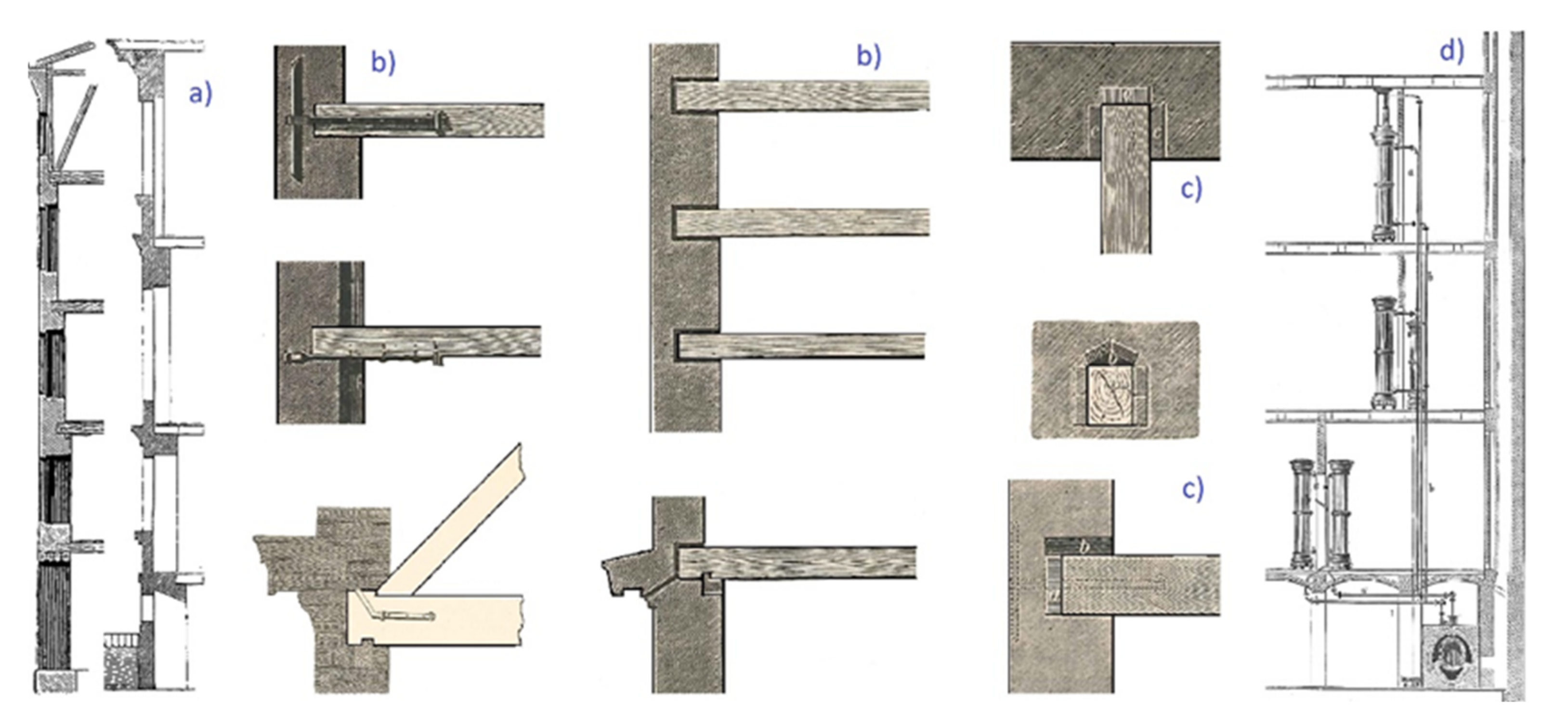

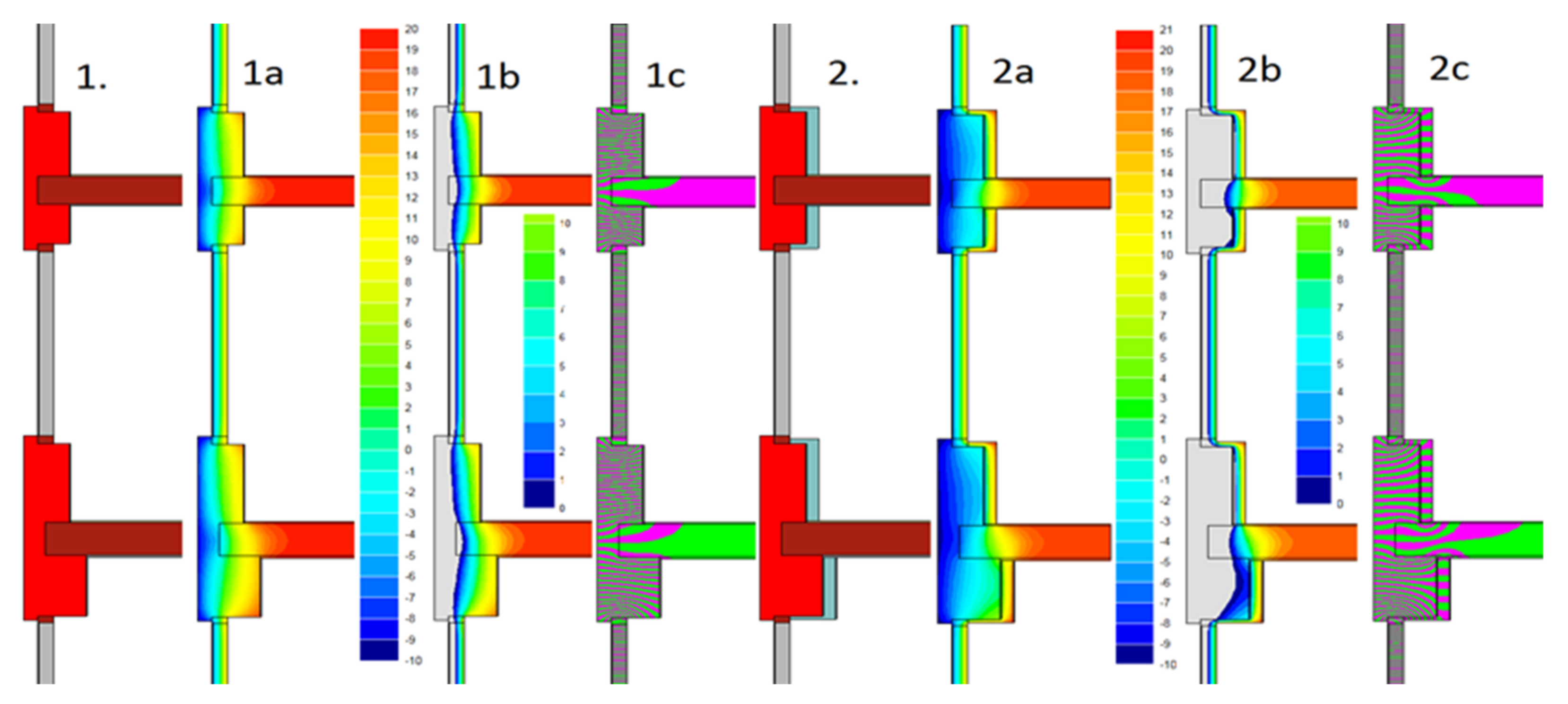
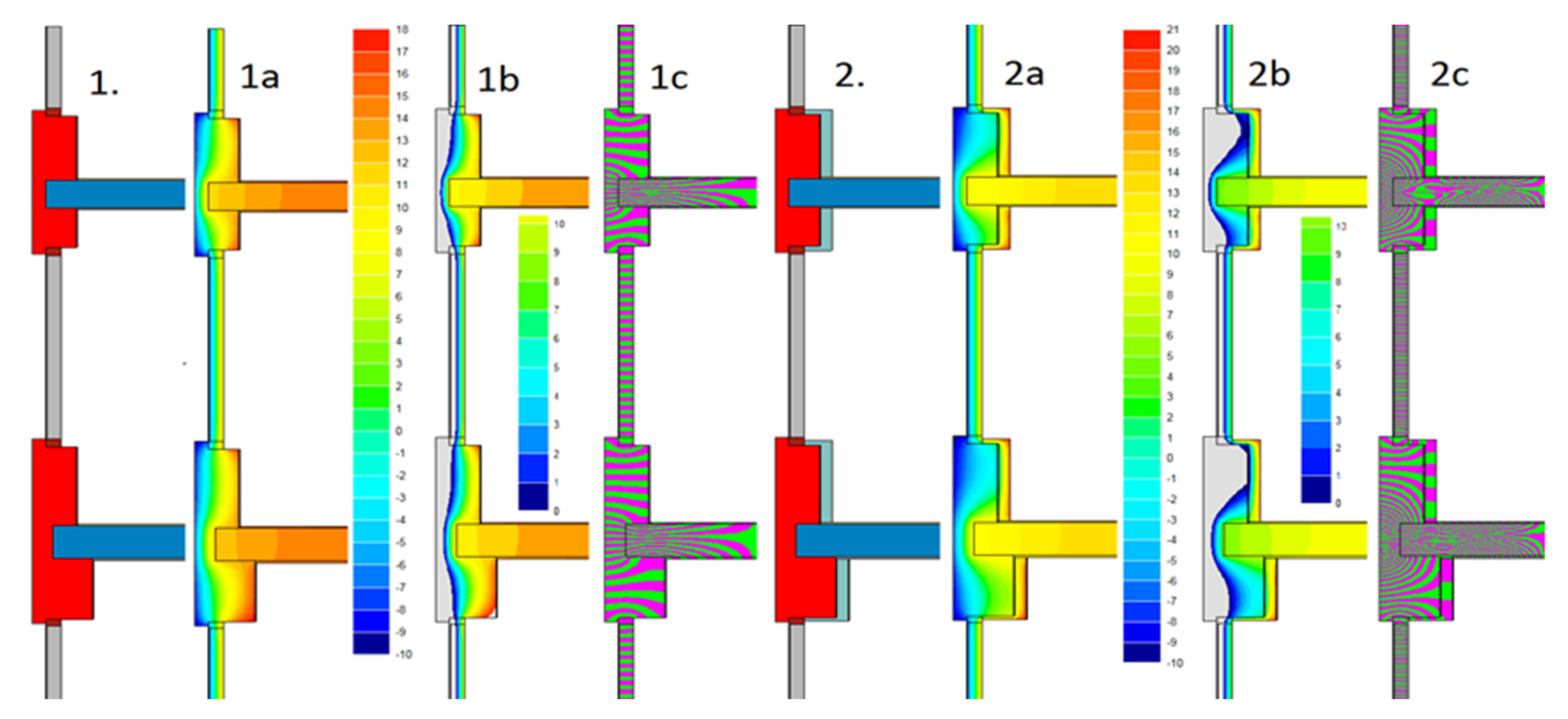



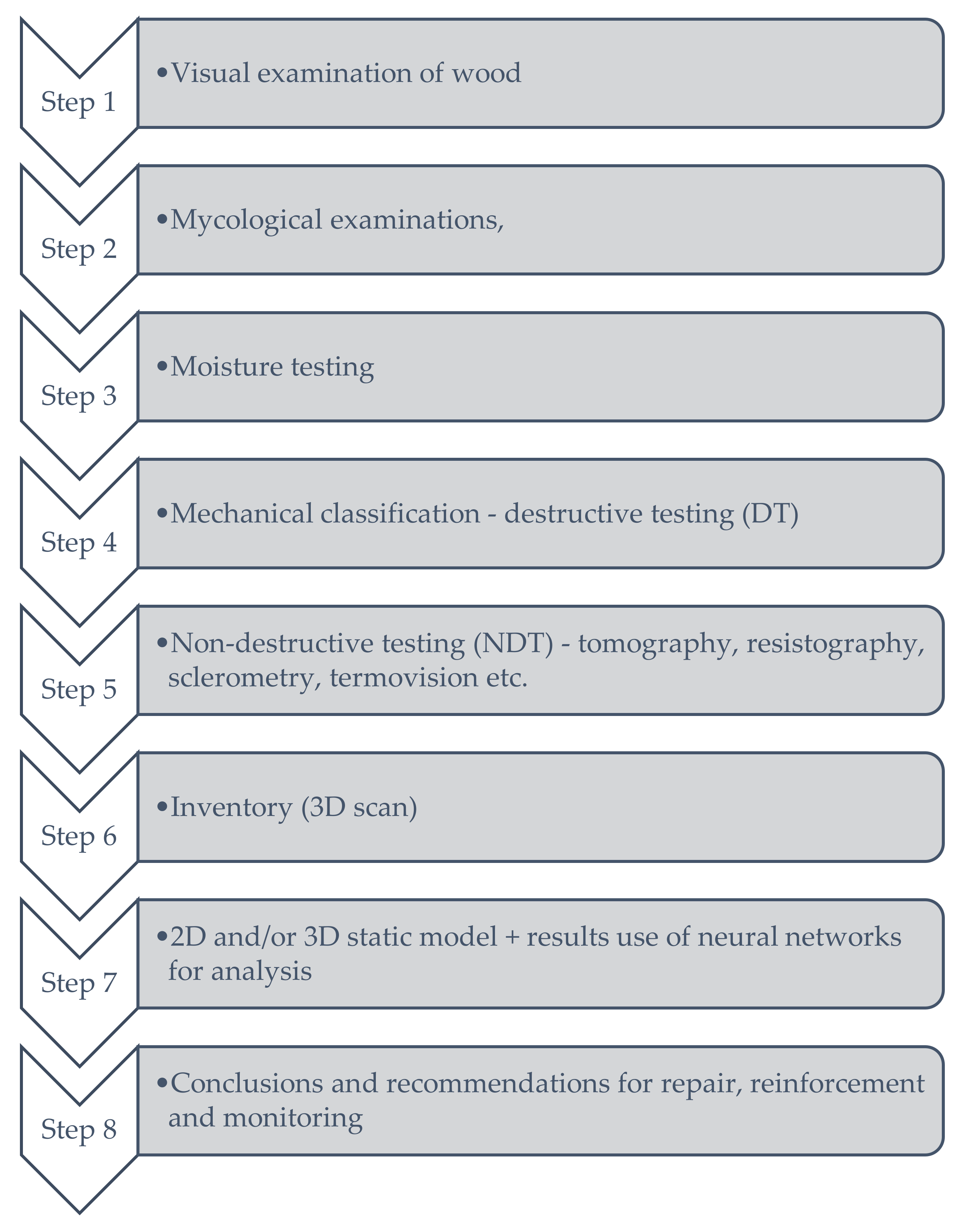

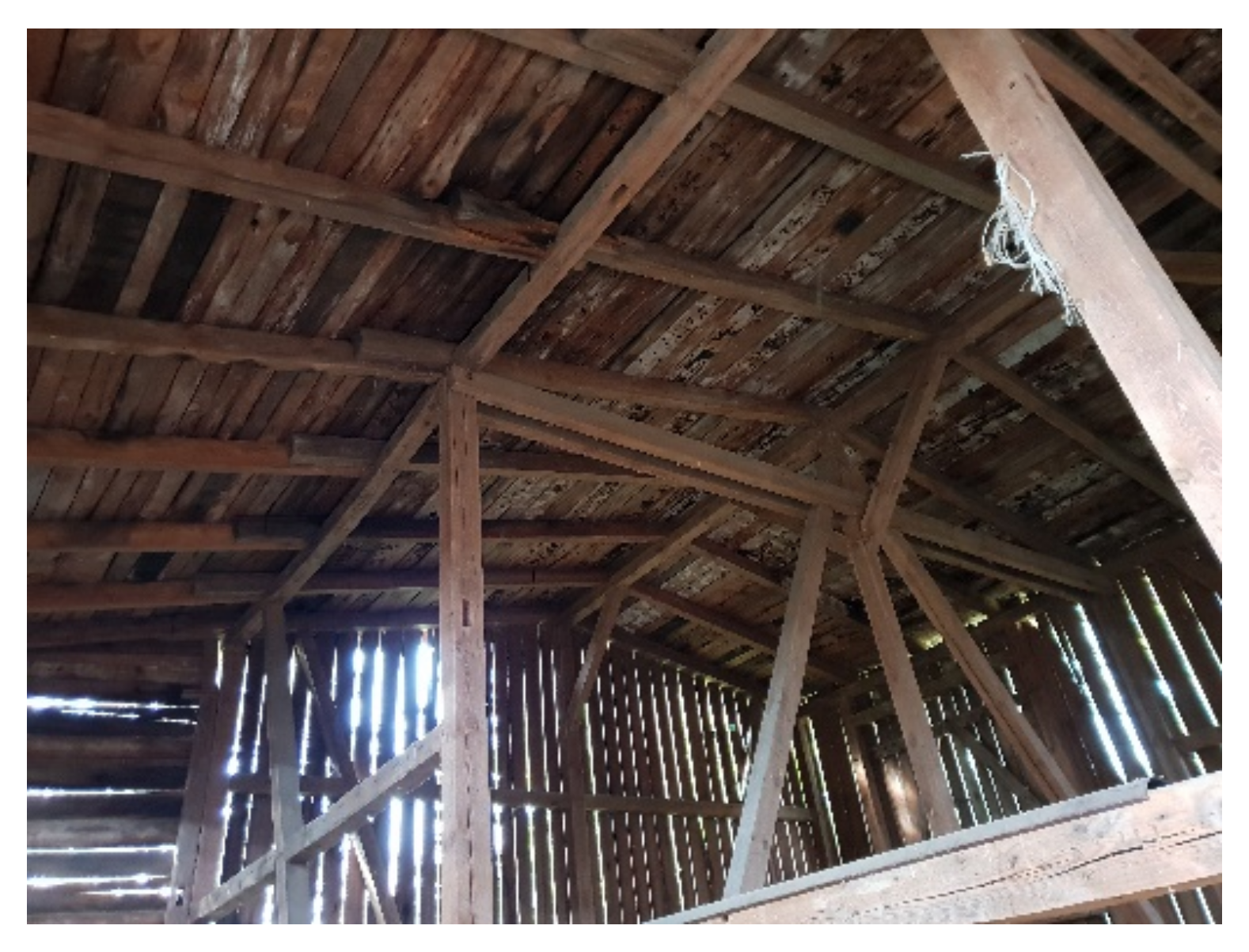
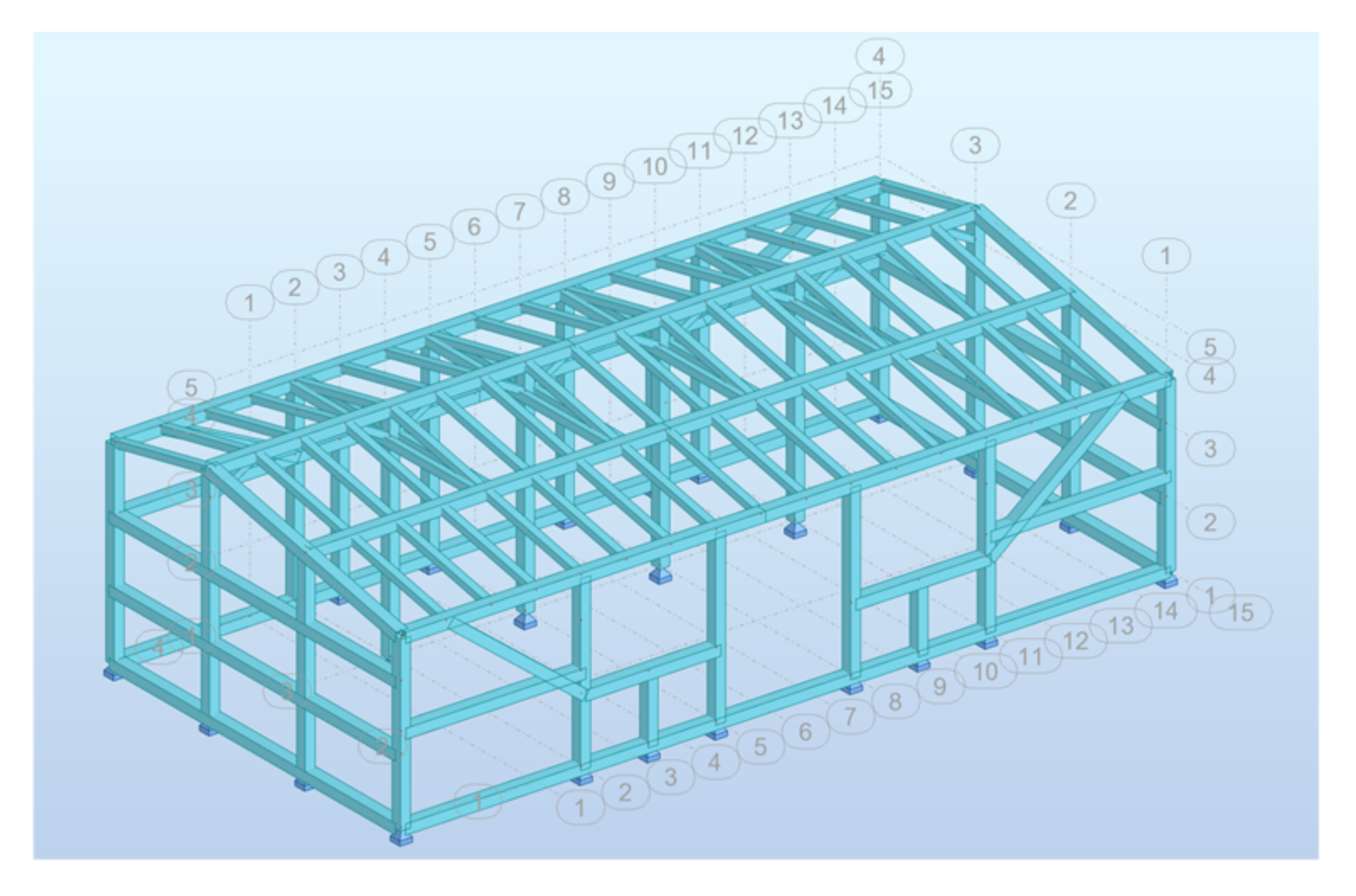
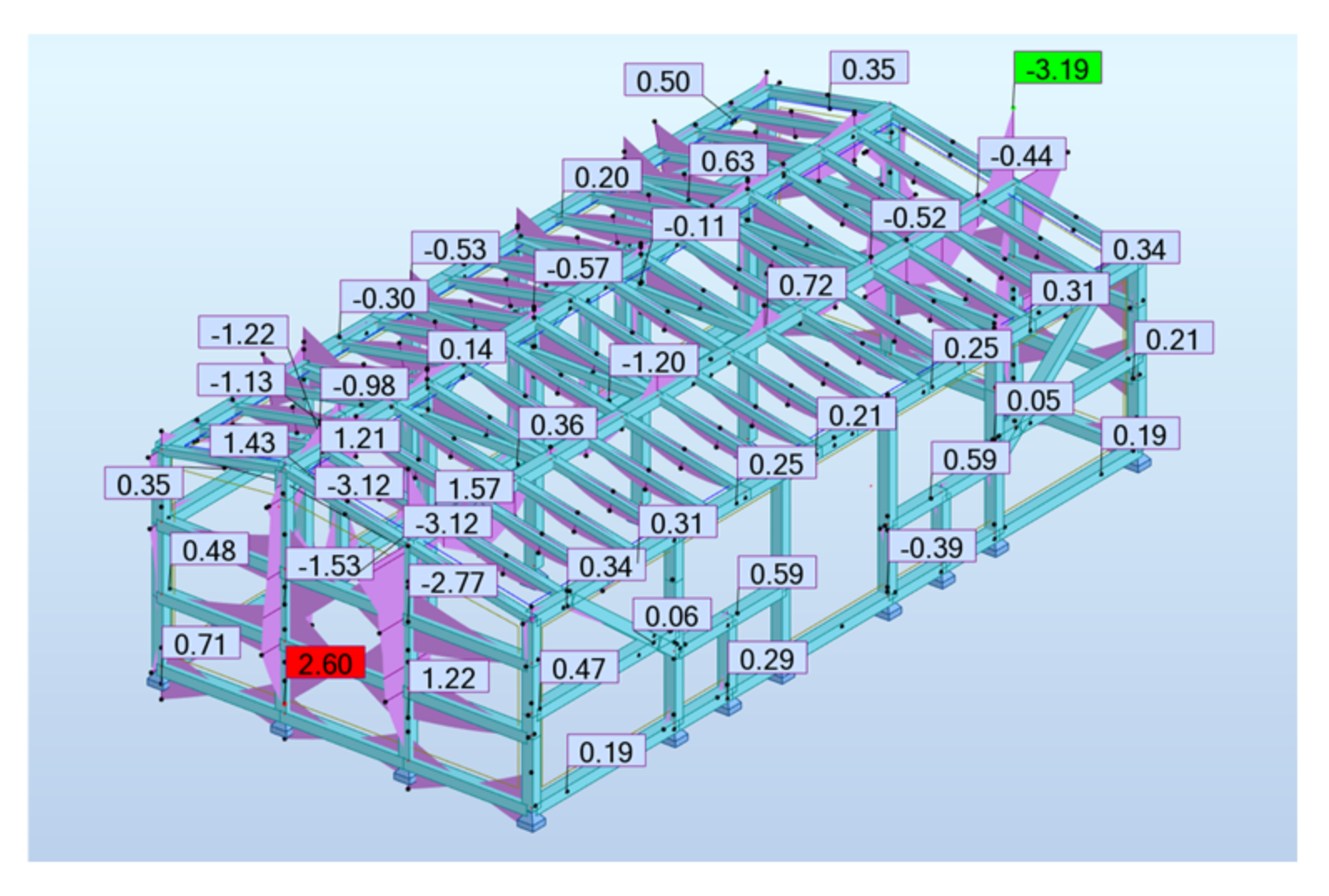
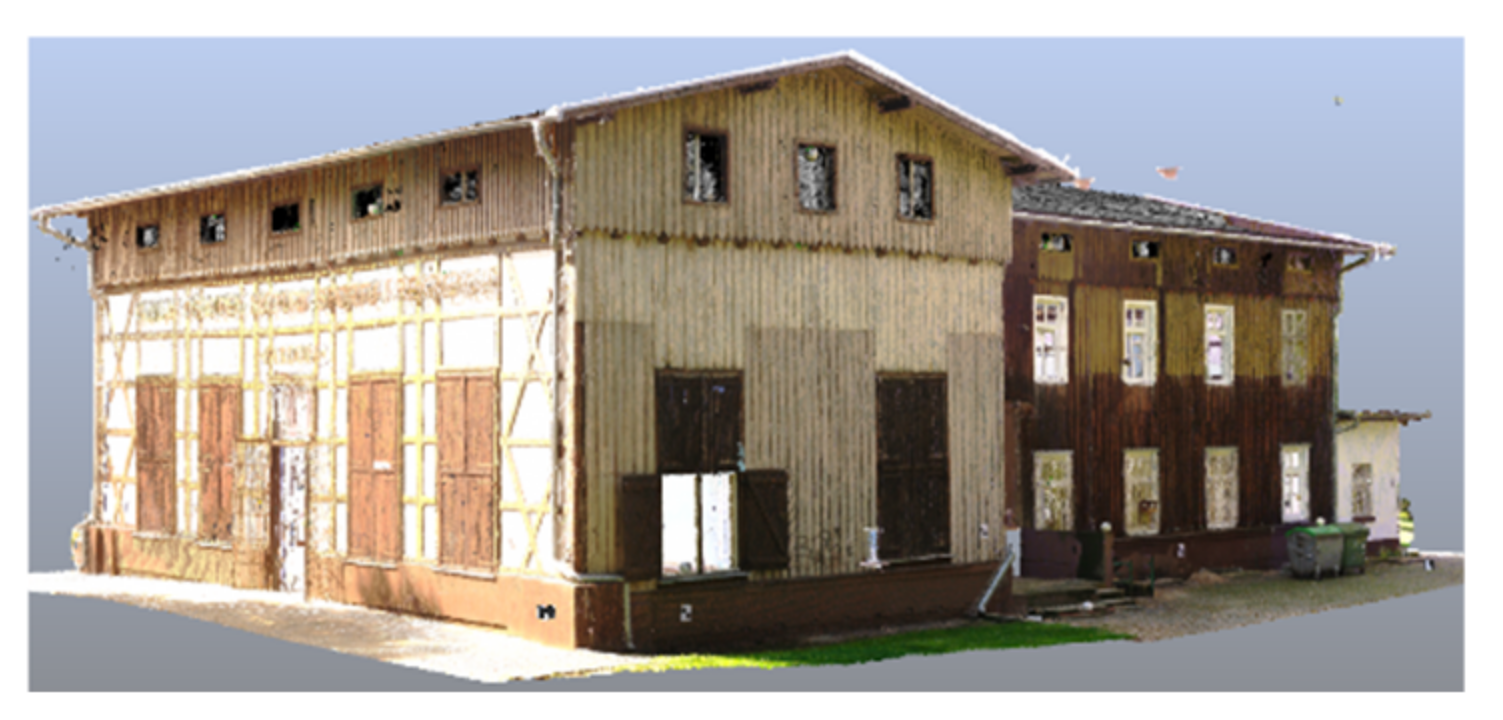
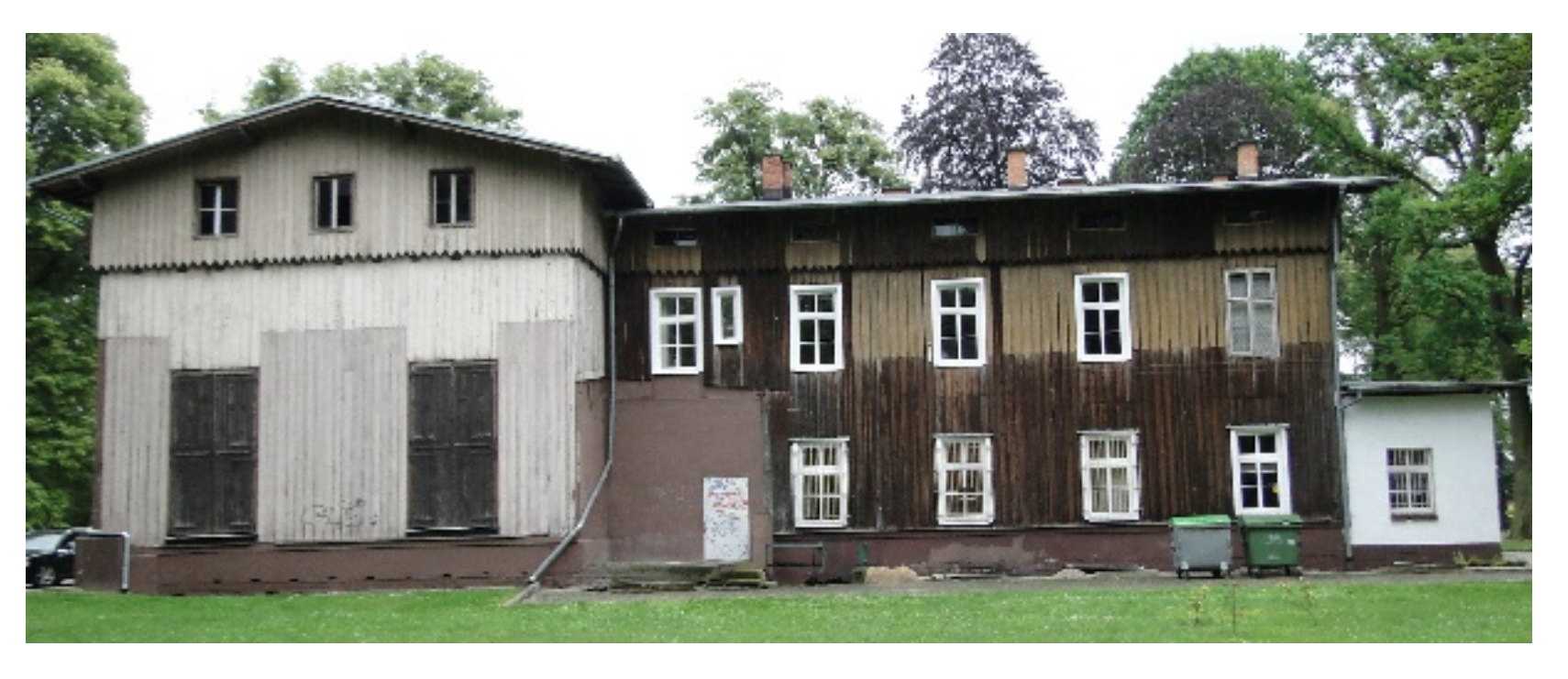
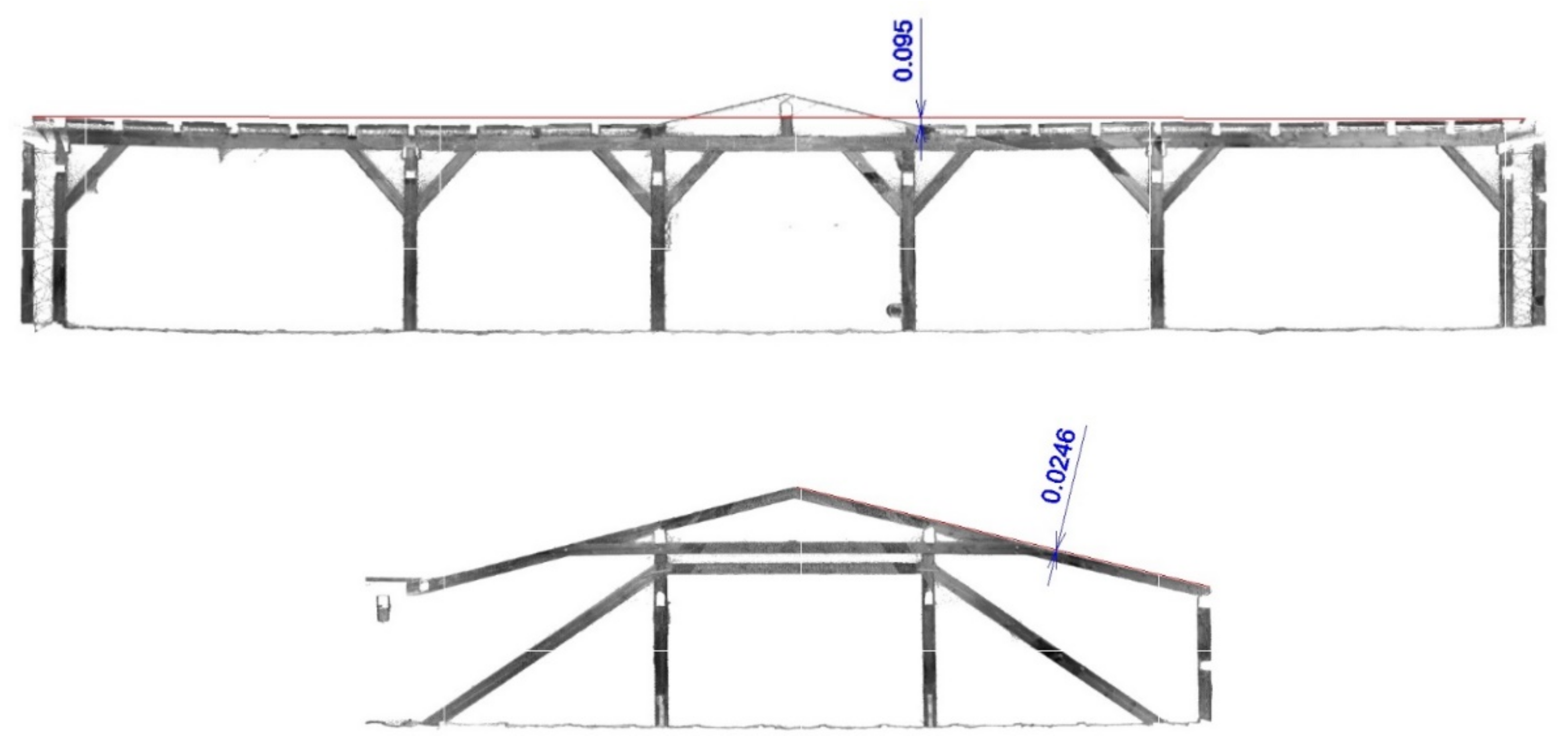
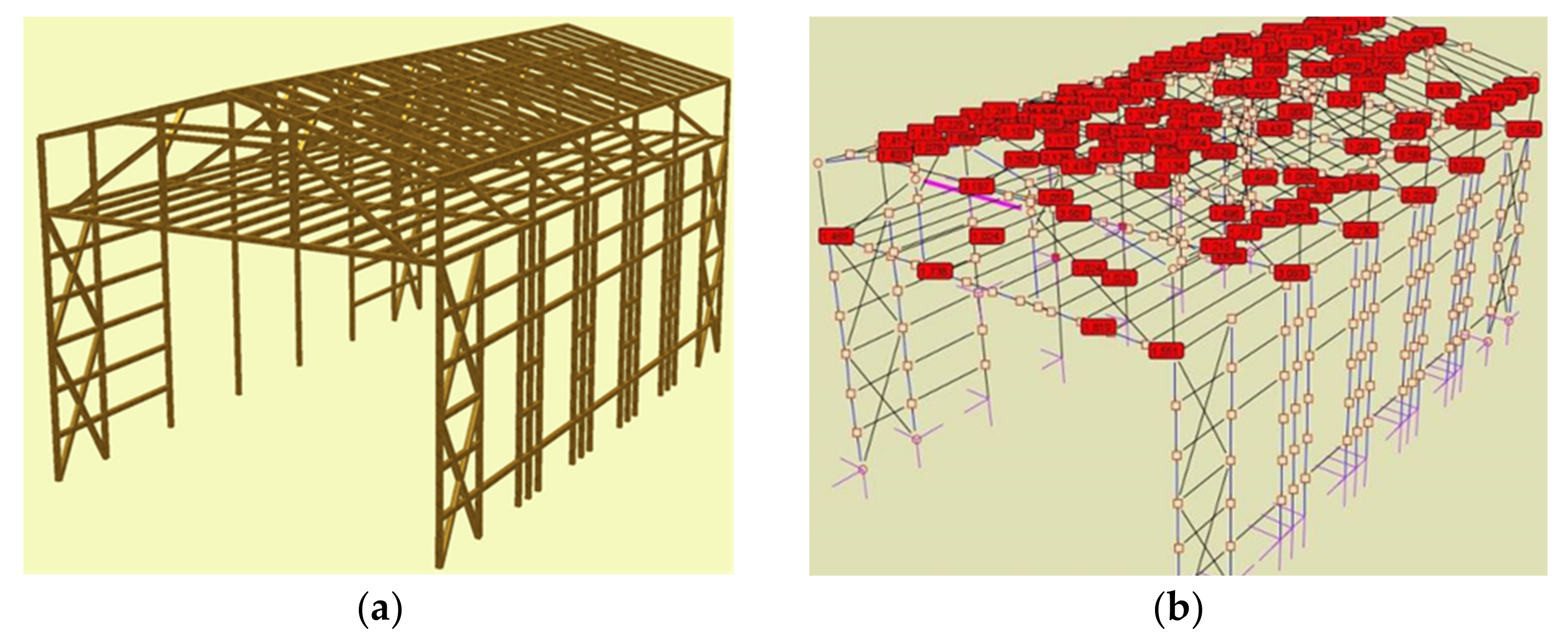



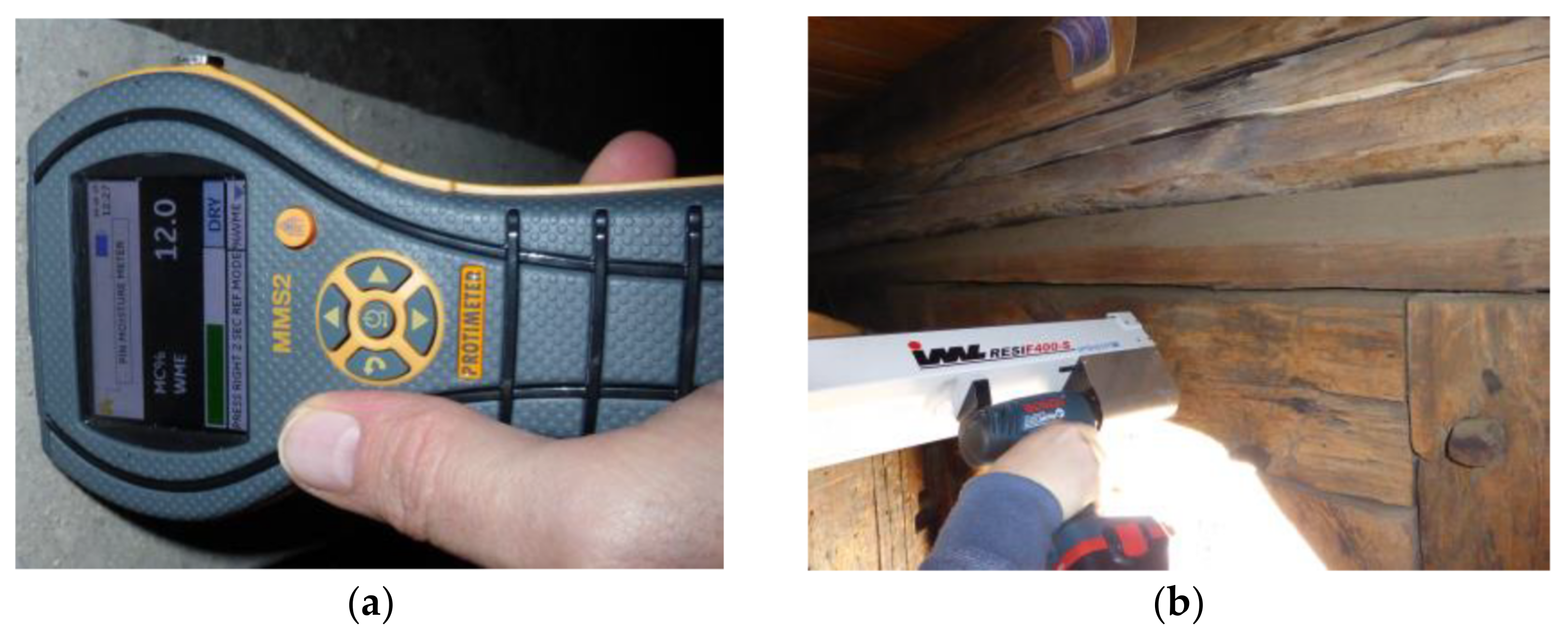
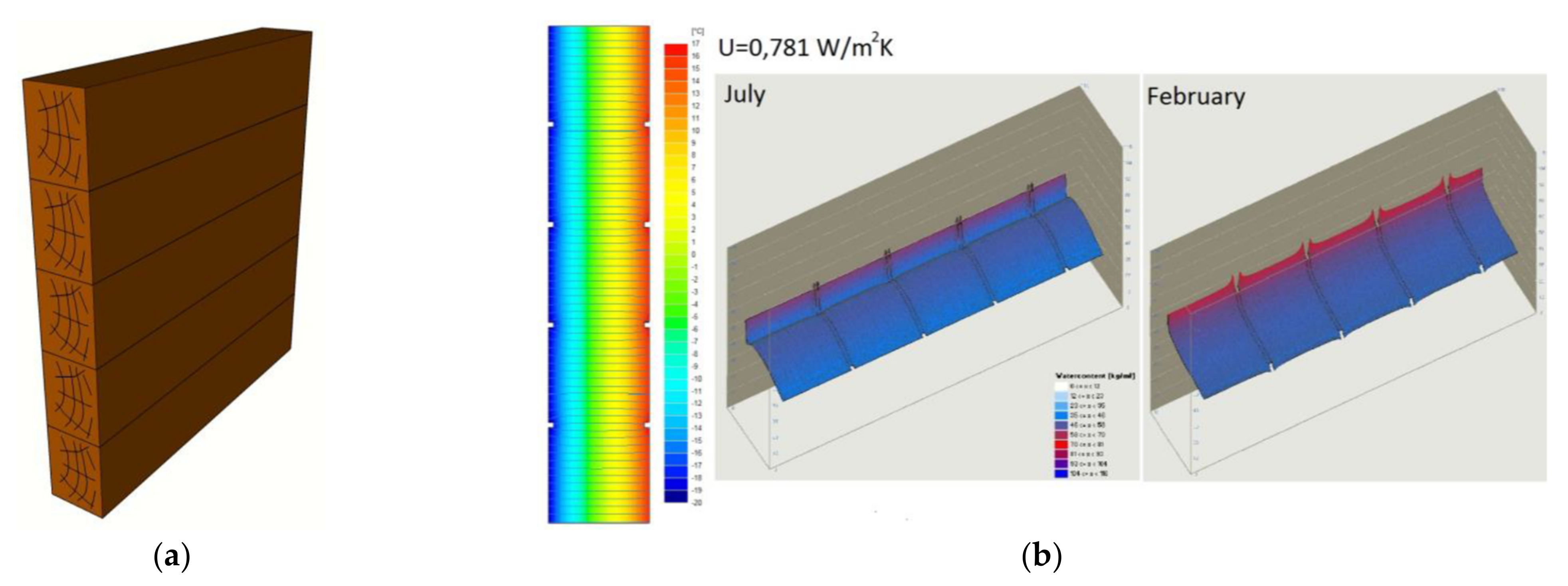

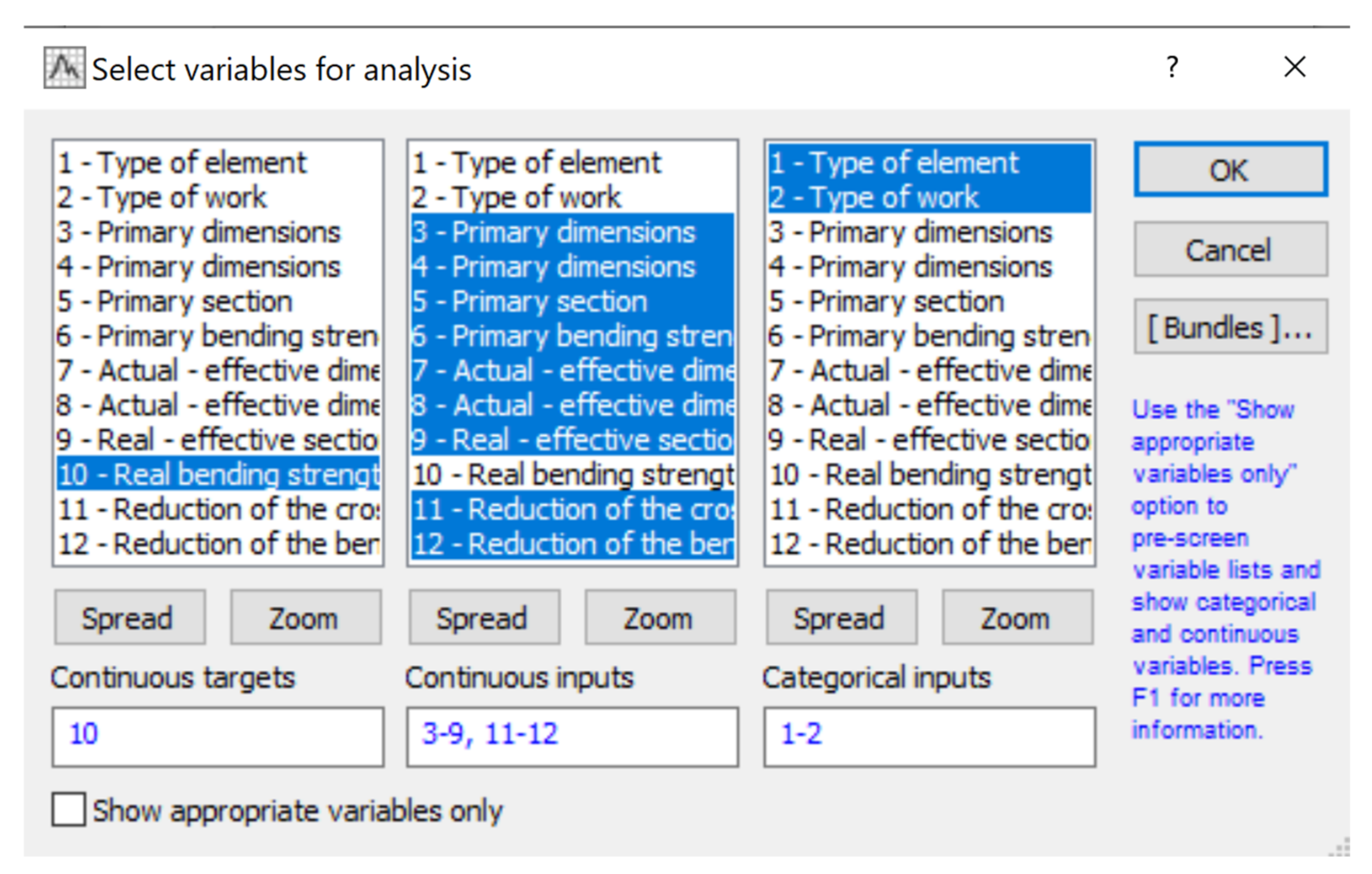

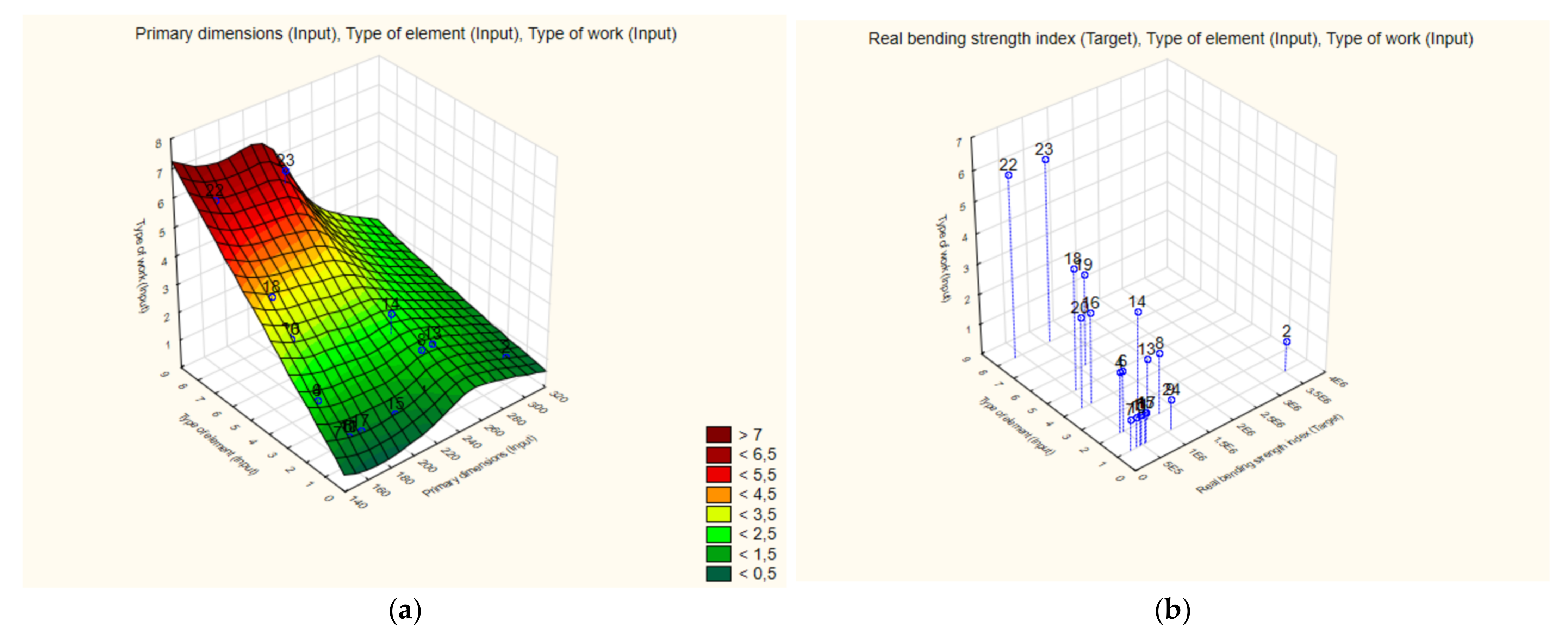
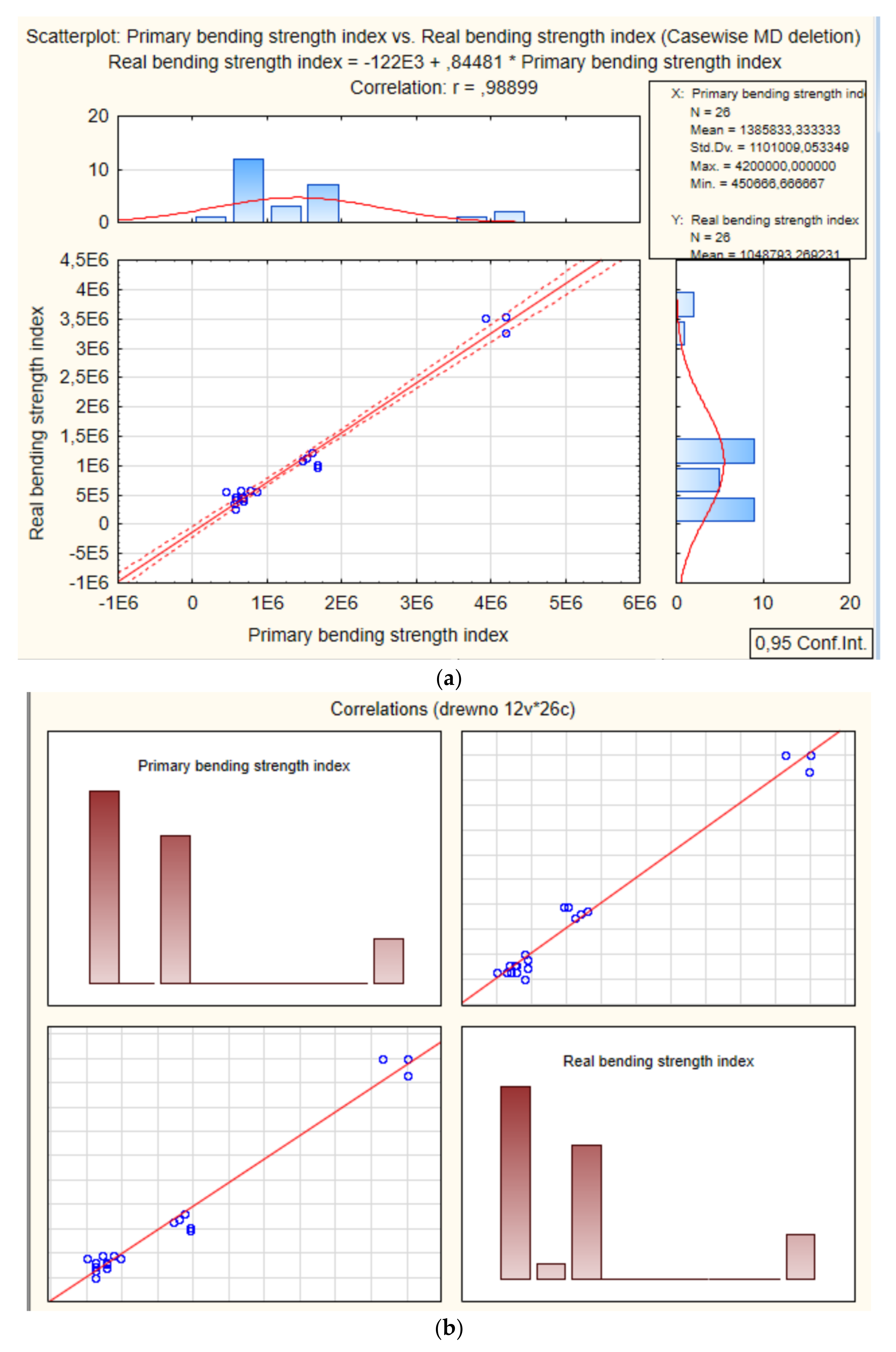

| No. | Type of Elment | Primary Dimensions | Primary Cross-Section | Dimensions Actual—Effective | Cross-Section Actual—Effective | Reduction in the Field Section |
|---|---|---|---|---|---|---|
| [mm × mm]. | [mm2]. | [mm × mm]. | [mm2]. | [%] | ||
| 1 | beam 1 | 230 × 200 | 46,000 | 210 × 180 | 37,800 | 18 |
| 2 | rafter | 160 × 130 | 20,800 | 150 × 120 | 18,000 | 13 |
| 3 | ticks | 160 × 130 | 20,800 | 150 × 120 | 18,000 | 13 |
| 4 | Bolt 1 | 160 × 130 | 20,800 | 150 × 120 | 18,000 | 13 |
| 5 | Bolt 2 | 220 × 200 | 44,000 | 200 × 180 | 36,000 | 18 |
| 6 | pole | 220 × 200 | 44,000 | 200 × 180 | 36,000 | 18 |
| 7 | foundation | 240 × 200 | 48,000 | 225 × 180 | 40,500 | 16 |
| 8 | beam 2 | 240 × 200 | 48,000 | 225 × 180 | 40,500 | 16 |
| Element No | Type of Element | Primary Dimensions | Primary Cross-section | Primary Flexural Strength Index | Actual Dimensions—Effective | Effective Cross-Section | Actual Flexural Strength Index | Change in Cross-Sectional Area | Change in Flexural Strength Index |
|---|---|---|---|---|---|---|---|---|---|
| [–] | - | [mm × mm]. | [mm2]. | [mm3]. | [mm × mm]. | [mm2]. | [mm3]. | [%] | [%] |
| 1 | pole | 280 × 300 | 84,000 | 4.20 × 106 | 270 × 280 | 75,600 | 3.53 × 106 | 90 | 84 |
| 2 | pole | 300 × 280 | 84,000 | 3.92 × 106 | 290 × 270 | 78,300 | 3.52 × 106 | 93 | 90 |
| 3 | pole | 280 × 300 | 84,000 | 4.20 × 106 | 250 × 280 | 70,000 | 3.27 × 106 | 83 | 78 |
| 4 | foundation | 150 × 150 | 22,500 | 5.63 × 105 | 110 × 150 | 16,500 | 4.13 × 105 | 73 | 73 |
| 5 | pole | 160 × 160 | 25,600 | 6.83 × 105 | 145 × 140 | 20,300 | 4.74 × 105 | 79 | 69 |
| 6 | foundation | 150 × 150 | 22,500 | 5.63 × 105 | 145 × 140 | 20,300 | 4.74 × 105 | 90 | 84 |
| 7 * | - | - | - | - | - | - | - | - | - |
| 8 | pole | 150 × 150 | 22,500 | 5.63 × 105 | 110 × 120 | 13,200 | 2.64 × 105 | 59 | 47 |
| 9 | foundation | 240 × 200 | 48,000 | 1.60 × 106 | 225 × 180 | 40,500 | 1.22 × 106 | 84 | 76 |
| 10 | pole | 220 × 200 | 44,000 | 1.47 × 106 | 200 × 180 | 36,000 | 1.08 × 106 | 82 | 74 |
| 11 | pole | 160 × 160 | 25,600 | 6.83 × 105 | 120 × 140 | 16,800 | 3.92 × 105 | 66 | 57 |
| 12 | pole | 160 × 160 | 25,600 | 6.83 × 105 | 140 × 140 | 19,600 | 4.57 × 105 | 77 | 67 |
| 13 | foundation | 250 × 200 | 50,000 | 1.67 × 106 | 210 × 170 | 35,700 | 1.01 × 106 | 71 | 61 |
| 14 | foundation | 250 × 200 | 50,000 | 1.67 × 106 | 200 × 170 | 34,000 | 9.63 × 105 | 68 | 58 |
| 15 | floor beam | 230 × 200 | 46,000 | 1.53 × 106 | 210 × 180 | 37,800 | 1.13 × 106 | 82 | 74 |
| 16 | pole | 200 × 160 | 32,000 | 8.53 × 105 | 170 × 140 | 23,800 | 5.55 × 105 | 74 | 65 |
| 17 | rafter | 160 × 130 | 20,800 | 4.51 × 105 | 150 × 120 | 18,000 | 3.60 × 105 | 87 | 80 |
| 18 | pole | 170 × 150 | 25,500 | 6.38 × 105 | 165 × 145 | 23,925 | 5.78 × 105 | 94 | 91 |
| 19 | purlin | 160 × 170 | 27,200 | 7.71 × 105 | 145 × 155 | 22,475 | 5.81 × 105 | 83 | 75 |
| Element No. | Type of Element | Type of Work | Primary Dimensions | Primary Cross-Section | Primary Flexural Strength Index | Actual Dimensions-Effective | Effective Cross-Section | Actual Flexural Strength Index | Reduction in the Cross-Sectional Area | Reduction in Flexural Strength Index |
|---|---|---|---|---|---|---|---|---|---|---|
| [mm × mm] | [mm2] | [mm3] | [mm × mm] | [mm2] | [mm3] | [%] | [%] | |||
| 1 | pole | eccentric compression along fibres | 280 × 300 | 84,000 | 4,200,000 | 270 × 280 | 75,600 | 3,528,000 | 10 | 16 |
| 2 | pole | eccentric compression along fibres | 300 × 280 | 84,000 | 3,920,000 | 290 × 270 | 78,300 | 3,523,500 | 7 | 10 |
| 3 | pole | eccentric compression along fibres | 280 × 300 | 84,000 | 4,200,000 | 250 × 280 | 70,000 | 3,266,666.67 | 17 | 22 |
| 4 | foundation | eccentric compression across fibres | 150 × 150 | 22,500 | 562,500 | 110 × 150 | 16,500 | 412,500 | 27 | 27 |
| 269 | shotgun | compression with bending along fibres | 160 × 130 | 20,800 | 554,666.67 | 150 × 120 | 18,000 | 360,000 | 13 | 35 |
| 270 | shotgun | compression with bending along fibres | 220 × 200 | 44,000 | 1,466,666.67 | 200 × 180 | 36,000 | 1,080,000 | 18 | 26 |
| 271 | pole | eccentric compression along fibres | 220 × 200 | 44,000 | 1,466,666.67 | 200 × 180 | 36,000 | 1,080,000 | 18 | 26 |
| 272 | foundation | eccentric compression across fibres | 240 × 200 | 48,000 | 1,600,000 | 225 × 180 | 40,500 | 1,215,000 | 16 | 24 |
| 273 | beam | bending in compression | 240 × 200 | 48,000 | 1,600,000 | 225 × 180 | 40,500 | 1,215,000 | 16 | 24 |
Publisher’s Note: MDPI stays neutral with regard to jurisdictional claims in published maps and institutional affiliations. |
© 2021 by the authors. Licensee MDPI, Basel, Switzerland. This article is an open access article distributed under the terms and conditions of the Creative Commons Attribution (CC BY) license (https://creativecommons.org/licenses/by/4.0/).
Share and Cite
Bajno, D.; Grzybowska, A.; Bednarz, Ł. Old and Modern Wooden Buildings in the Context of Sustainable Development. Energies 2021, 14, 5975. https://doi.org/10.3390/en14185975
Bajno D, Grzybowska A, Bednarz Ł. Old and Modern Wooden Buildings in the Context of Sustainable Development. Energies. 2021; 14(18):5975. https://doi.org/10.3390/en14185975
Chicago/Turabian StyleBajno, Dariusz, Agnieszka Grzybowska, and Łukasz Bednarz. 2021. "Old and Modern Wooden Buildings in the Context of Sustainable Development" Energies 14, no. 18: 5975. https://doi.org/10.3390/en14185975
APA StyleBajno, D., Grzybowska, A., & Bednarz, Ł. (2021). Old and Modern Wooden Buildings in the Context of Sustainable Development. Energies, 14(18), 5975. https://doi.org/10.3390/en14185975







